Author: pbecadmin

Dr. Marilyn Connor of Palm Beach Equine Clinic Discusses Balancing Your Horse’s Energy Sources for Performance
The modern equine athlete is asked to train and compete at far more demanding levels than horses in nature. Providing your horse with a diet that matches their metabolic needs, activity level, and training demands is key to success. To fuel our sport horses, we must first understand their nutrition and energy needs and give them the adequate support to succeed.
Physical Demands
Anaerobic vs. Aerobic Exercise

Glucose is stored in the liver and muscle cells as Glycogen, or a complex carbohydrate. Glycogen is broken down into glucose to meet metabolic energy requirements and provides energy for short to medium duration physical activity. Additionally, fat can be broken down and converted into glucose through a longer and more complex process.
Exercise can be characterized into two general categories: anaerobic and aerobic. Anaerobic exercise is characterized by short bursts of maximal effort activity, while aerobic exercise includes low to moderate intensity activity that lasts for a longer duration.
Both anaerobic and aerobic exercise utilize glucose as the primary source of fuel. Anaerobic and aerobic exercise differ in their secondary source of energy utilized once circulating glucose is depleted. Anaerobic exercise utilizes glycogen stores after glucose is depleted, while aerobic exercise is fueled by fat sources.
No equestrian sport is entirely anaerobic or aerobic. Most disciplines will have periods that require anaerobic and aerobic energy metabolism. Racehorses and western performance horses work at high intensity, fast speeds for short periods of time, requiring the body to utilize anerobic metabolism to produce energy. Show jumping and polo horses primarily use aerobic exercise yet will switch to anaerobic metabolism to keep up with energy demands of their sport. Eventing and endurance racing horses rely primarily on aerobic metabolism to support their energy needs over long periods of activity.
To support your horse during any type of sport, they must have a balanced nutrition program that sets them up for success.
Forage First

“Providing high quality forage is always my top focus for any nutrition program, regardless of the horse’s breed, age, gender, metabolic needs or athletic activity,” says Dr. Connor.
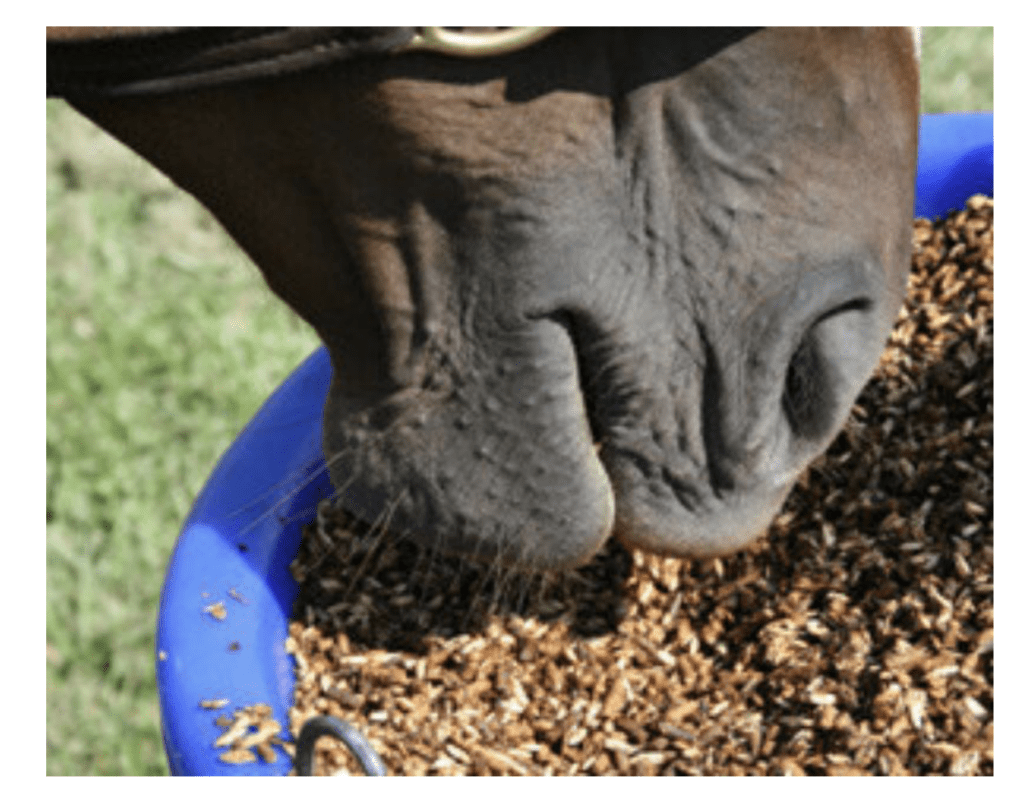
Horses are herbivores and evolved to survive by grazing on a steady supply of fresh grasses and plants. Research conducted on horses in nature shows that the average wild horse will spend 15 to 17 hours per day grazing and will travel 20 to 30 miles per day in their search for adequate food and water sources. To accommodate for the lifestyle of the modern sport horse, owners must provide high quality forage sources.
Fresh grass contains an optimal blend of key nutrients including protein, carbohydrates, vitamins and fatty acids. Once grass is cut, dried and baled as hay, the nutritional benefits begin decreasing. A week after cutting, hay loses about 60% of its vitamin A, E, and Omega 3 fatty acid content. As a general rule, horses should consume 1 to 1.5% of their body weight in hay or forage per day, with some high performing equine athletes requiring 2 to 2.5% to meet their energy needs.
When hay and forage alone are not enough to support the intense metabolic needs of the equine athlete, grain, and concentrated feed become an important part of the nutritional plan.
Building Blocks of Energy Sources
Feeding your horse with the appropriate mixture of carbohydrates, proteins, and fat is essential for fueling athletic performance.
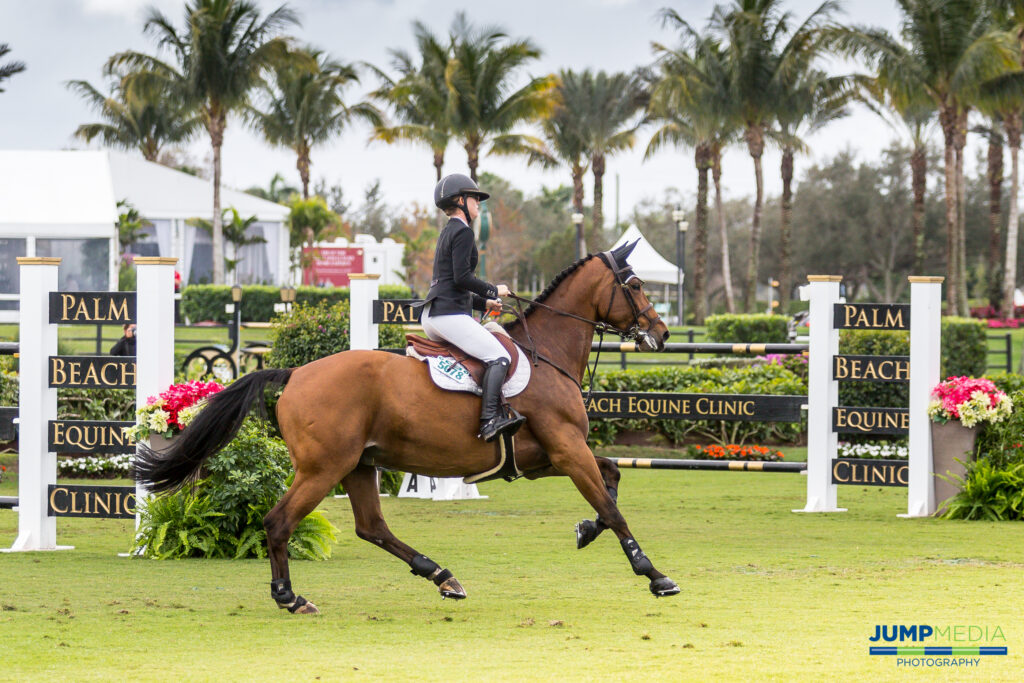

A horse whose training requires a high level of aerobic exercise, such as a dressage horse, should receive an adequate amount of fat and carbohydrates in their diet to fuel them through longer duration training sessions by providing extended, long-lasting energy sources. Racing and barrel horses, utilizing anaerobic exercise, require a higher percentage of carbohydrates in their diets to support them through maximal effort exercise for shorter periods of time.
Carbohydrates are sourced from forage, grains, and concentrated feeds. Forage sources provide a complex source of fibrous carbohydrates that require more time for the body to digest. Concentrated feeds and grains contain starchy carbohydrates that are easily digested and quickly converted into energy to fuel a horse through intense training. A well-balanced concentrated feed will also have an appropriate blend of fat, protein, and trace minerals.
Protein is an important part of the equine diet and is found in fresh grass, dried forage, and concentrated feeds in varying amounts. Protein is made of amino acids, which are the building blocks for growth, development, repair, and maintenance of body tissues. The modern equine athlete requires a substantial amount of dietary protein to support muscle growth and ongoing tissue repair.
Fat is a key component in most equine concentrated feeds and may be supplemented by adding flax seeds, flax oil, rice bran, and corn oil. These fat sources will provide slow burning calories for sustained energy release. Fat can be especially useful for supplementing a horse’s diet when they are a “hard keeper” or if they have an underlying metabolic condition that requires dietary carbohydrates to be limited.
It is important to remember that not all fats are created equal; as some fat sources can decrease or increase inflammation in the body. Flax seed and flax seed oil are rich in anti-inflammatory omega 3 fatty acids and can be an excellent source of energy. Corn oil is commonly used to add calories and fat; however, it is a less desirable supplement due to its higher percentage of omega 6 fatty acids, which contribute to inflammation. Concentrated feeds will have varying levels of added fats depending on the type of horse it is designed to feed.
Balancing Your Horse’s Energy Sources for Performance
Whatever equestrian discipline is your passion, your horse will need to be fueled by a balanced nutritional plan.
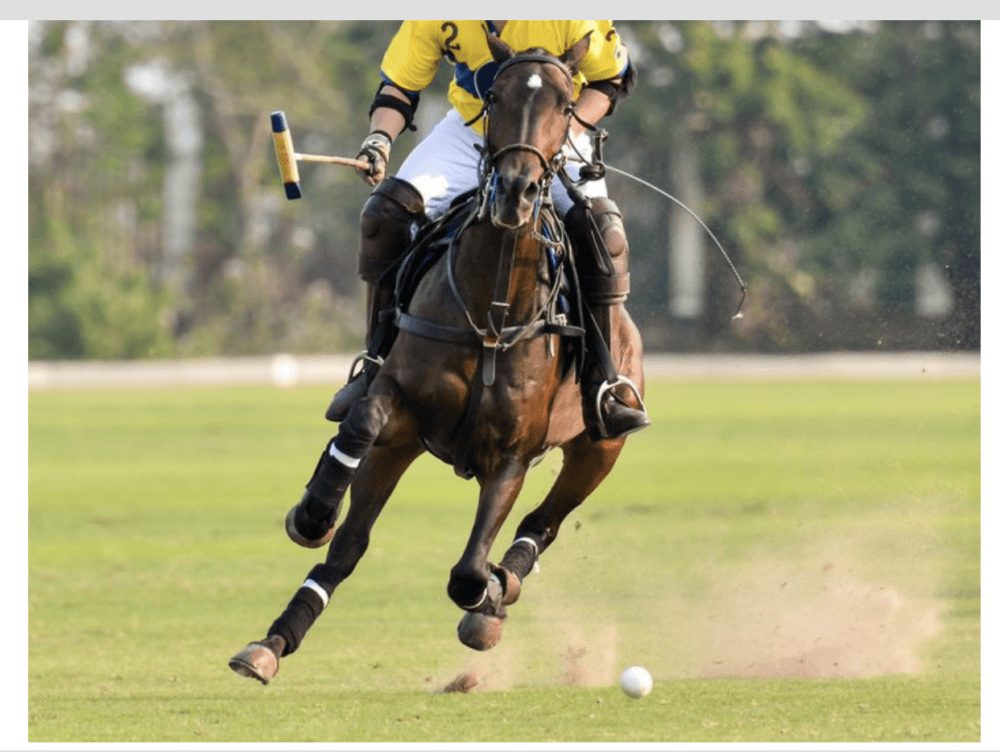
“Feeding instructions provided on grains and concentrated feed products are designed by nutritional companies as guidelines; they are not rules and should be adjusted based on total sources of nutrition,” said Dr. Connor.
Establishing the proper balance of forage, starchy carbohydrates, fat sources, vitamins, and minerals will be different for each unique horse and the demands placed upon them.
Understanding the nutritional demands of your horse can be very simple or very intricate, depending on your unique equine athlete. When designing a feeding program, it is important take into consideration your horse’s athletic discipline, performance level, metabolic needs, stage of life, and any underlying medical conditions. Furthermore, your horse’s nutritional needs will vary over time and as they age, so it is important to periodically assess your horse’s body condition and consult with a knowledgeable veterinarian.
Speak with Dr. Marilyn Connor of Palm Beach Equine Clinic about your horse’s unique nutritional needs to ensure your horse is fully supported and on track to reach your competitive goals.
Schedule a Nutritional Consultation with Dr. Connor
Fill out the form below or call 561-793-1599 to get started.
When the Bone Breaks
Palm Beach Equine Clinic is Changing the Prognosis for Condylar Fracture Injuries
Palm Beach Equine Clinic is changing the prognosis for condylar fracture injuries in race and sport horses. Advances in diagnostic imaging, surgical skillset, and the facilities necessary to quickly diagnose, treat, repair, and rehabilitate horses with condylar fractures have improved dramatically in recent years.

Photo by Jump Media
Most commonly seen in Thoroughbred racehorses and polo ponies, a condylar fracture was once considered a career-ending injury. Today, however, many horses fully recover and return to competing in their respective disciplines.
What is a Condylar Fracture?
A condylar fracture is a repetitive concussive injury that results in a fracture to the cannon bone above the fetlock due to large loads transmitted over the cannon bone during high-speed exercise. On a radiograph, a condylar fracture appears as a crack that goes laterally up the cannon from the fetlock joint and out the side of the bone, essentially breaking off a corner of the cannon bone, sometimes up to six inches long.

“A condylar fracture is a disease of speed,” said Dr. Robert Brusie, a surgeon at Palm Beach Equine Clinic who estimates that he repairs between 30 and 50 condylar fractures per year. “A fracture to the left lateral forelimb is most common in racehorses as they turn around the track on a weakened bone and increased loading.”

Condylar fractures are further categorized into incomplete and non-displaced (the bone fragment hasn’t broken away from the cannon bone and is still in its original position), or complete and displaced (the fragment has moved away from the cannon bone itself and can often be visible under the skin).
Additionally, condylar fractures can occur laterally or medially. According to fellow Palm Beach Equine Clinic surgeon Dr. Weston Davis, most condylar fractures tend to be lateral on the outside condyle (a rounded projection on a bone, usually for articulation with another bone similar to a knuckle or joint).
“Most lateral condylar fractures are successfully repaired,” said Dr. Davis. “Medial condylar fractures tend to be more complicated configurations because they often spiral up the leg. Those require more advanced imaging and more advanced techniques to fix.”
What is the Treatment?
The first step in effectively treating a condylar fracture through surgery is to accurately and quickly identify the problem. Board-certified radiologist Dr. Sarah Puchalski utilizes the advanced imaging services at Palm Beach Equine Clinic to accomplish exactly this.
“Stress remodeling can be detected early and easily on nuclear scintigraphy before the horse goes lame or develops a fracture,” said Dr. Puchalski. “Early diagnosis of stress remodeling allows the horse to be removed from active race training and then return to full function earlier. Early diagnosis of an actual fracture allows for repair while the fracture is small and hopefully non-displaced.”

Photo by Jump Media
Once the injury is identified as a condylar fracture, Palm Beach Equine Clinic surgeons step in to repair the fracture and start the horse on the road to recovery. Depending on surgeon preference, condylar fracture repairs can be performed with the horse under general anesthesia, or while standing under local anesthesia. During either process, surgical leg screws are used to reconnect the fractured condyle with the cannon bone.
“For a small non-displaced fracture, we would just put in one to two screws across the fracture,” explains Dr. Davis. “The technical term is to do it in ‘lag fashion,’ such that we tighten the screws down heavily and really compress the fracture line. A lot of times the fracture line is no longer visible in x-rays after it is surgically compressed. When you get that degree of compression, the fractures heal very quickly and nicely.”
More complicated fractures, or fractures that are fully displaced, may require additional screws to align the parts of the bone. For the most severe cases of condylar fractures, a locking compression plate with screws is used to stabilize and repair the bone.
Palm Beach Equine Clinic surgeon Dr. Jorge Gomez approaches a non-displaced condylar fracture while the horse is standing, which does not require general anesthesia.

“I will just sedate the horse and block above the site of the fracture,” said Dr. Gomez. “Amazingly, horses tolerate it really well. Our goal is always to have the best result for the horse, trainers, and us as veterinarians.”
According to Dr. Gomez, the recovery time required after a standing condylar fracture repair is only 90 days. This is made even easier thanks to a state-of-the-art standing surgical suite at Palm Beach Equine Clinic. The four-and-a-half-foot recessed area allows doctors to perform surgeries anywhere ventral of the carpus on front legs and hocks on hind legs from a standing position. Horses can forgo general anesthesia for a mild sedative and local nerve blocks, greatly improving surgical recovery.
“A condylar fracture was once considered the death of racehorses, and as time and science progressed, it was considered career-ending,” concluded Dr. Brusie. “Currently, veterinary medical sciences are so advanced that we have had great success with condylar fracture patients returning to full work. Luckily, with today’s advanced rehabilitation services, time, and help from mother nature, many horses can come back from an injury like this.”
5 Questions for Dr. Jordan Lewis

Dr. Jordan Lewis is a graduate of the University of Florida College of Veterinary Medicine and has dedicated her professional career to serving her home state. Dr. Lewis grew up with horses and completed an internship in equine medicine and surgery at the Equine Medical Center in Ocala.
Get to know Dr. Lewis:
1. What is your background with horses?
I moved from New York City to Fort Lauderdale, FL, when I was eight years old. My dad grew up loving horses, and when I was two, he bought a horse. We would travel from our home in New York City to visit him in the Pocono Mountains every weekend to ride. My first experience on a horse was riding double with my dad through cornfields. When I was eight years old, we moved to Florida and I was lucky enough to get my own pony. I got totally hooked on horses and I competed on the Arabian circuit as a teenager.
2. What inspired you to pursue veterinary medicine?
As a child, I participated in local 4-H programs and had the experience of touring an equine surgical and rehabilitation facility. I realized early that this was exactly what I wanted to do as my career.
3. When did you join Palm Beach Equine Clinic and what is your specialty?
I joined the team at Palm Beach Equine Clinic in June of 2005. I love the fact that we have such a dynamic team of veterinarians to work with and consult on difficult cases. I wouldn’t say I have a main focus as I am able to do everything from sports medicine and lameness exams to reproduction work thanks to the clinic’s wide range of cases and capabilities.

4. What advice would you give someone who wants to become an equine vet?
I would tell them that a career in large animal veterinary care is not just a job, it is a lifestyle. If it is what you are meant to do, you will love every minute of this lifestyle. I get to be outside and around horses all day. For me, this is the greatest profession.
5. What is one of the most interesting cases you have worked on?
The most interesting case I have worked on was a pericardial effusion. The condition is caused by excess fluid between the heart and the sac surrounding the heart, known as the pericardium. To remove the fluid, I performed a pericardiocentesis, which involved placing a drain within the sac around the heart to drain the excess fluid and relieve pressure on the heart. That is not something you get to do every day!
Horse Health Reminder: Hydration
Even in the winter months, it is important not to underestimate the heat, humidity, and sun. Palm Beach Equine Clinic stresses the importance of proper hydration and sun protection year-round, especially to Florida-based equestrians and winter season snowbirds.
There are many problems that can arise when temperatures climb, including overheating, dehydration, and colic. When the weather becomes chilly in Florida, horses often quit drinking as much water. This can lead to additional problems such as impaction. Your horse’s hydration is critically important for health and performance
Remember these 5 easy ways to protect your horse from sun and dehydration:
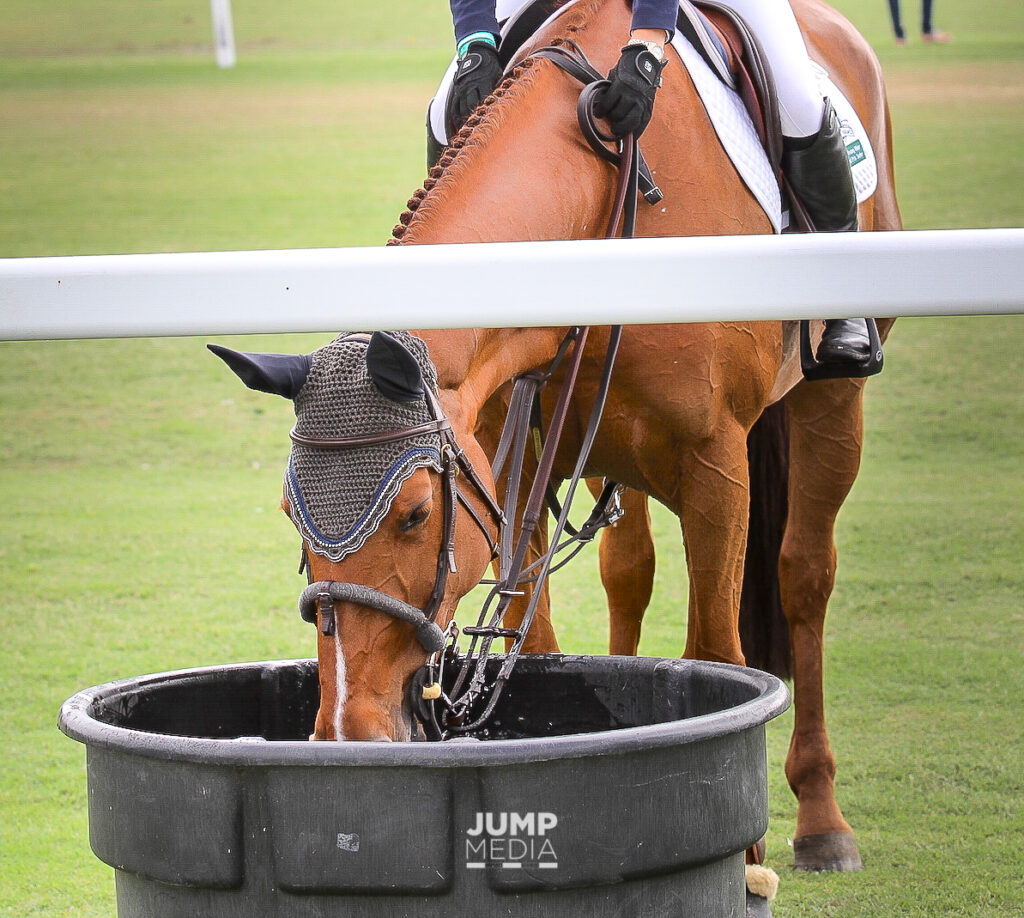
1. During extended periods of turnout, and when competing, horses should always have access to shaded areas. Scheduled rides and extended turnout should take place when the temperatures are lower, usually early mornings or in the evening on hot days, so the horse is not in direct sunlight.
2. The average horse drinks between five and 10 gallons of water per day. Therefore, easy and frequent access to clean, fresh water is a necessity. Pay special attention to increased intake during particularly hot days and plan accordingly.
3. Sodium in a horse’s diet is crucial for maintaining proper hydration. Providing a salt block or supplementing with properly measured electrolytes in a horse’s feed or water can help ensure that sodium requirements are being met and that your horse is drinking a sufficient amount of water.

4. Especially in the extreme summer heat, horse owners should pay attention to the amount of sweat their horse is producing. Anhidrosis, or the inability to sweat normally, can be a common challenge, particularly in hot, humid climates. In addition to lack of sweat, signs of anhidrosis can include increased respiratory rate, elevated temperature, areas of hair loss, or dry and flaky skin. If you notice any of these signs, contact Palm Beach Equine Clinic immediately.
5. Clean water buckets often and always fill with fresh water before leaving the barn. Veterinarians often recommend placing one bucket of fresh water and one bucket of electrolytes. Usually, a horse will balance his electrolytes with the opportunity to drink from one or more of these buckets.
These are just a few of the important issues to be aware of during the temperature change in Florida. Contact Palm Beach Equine Clinic to learn more about precautions that can be taken to keep horses happy and healthy throughout the winter competition season.
Typically, when a horse’s gait feels off or may be lacking usual impulsion, the rider often assumes it to be an issue of lameness associated with the forelimbs or hindlimbs. However, that may not always be the case. Utilizing advanced diagnostic imaging techniques, Palm Beach Equine Clinic is able to accurately pinpoint the specific area that is affecting overall performance. In many cases, the cervical vertebrae are often identified as the cause of lameness, asymmetry, and poor performance.
Vertebral Anatomy

The neck is composed of seven articulating cervical vertebrae running from the head to the thorax, named C1 through C7. The neck allows movement of the head while protecting the spinal cord and providing an avenue for nerves to travel. Impingement on the spinal cord and nerves connected to the cervical vertebrae can exhibit neurologically as ataxia, neck pain, or lameness.
Signs of Lameness Related to the Neck
In a lameness exam, a veterinarian will perform flexion tests and palpate areas of the body looking for decreases in the horse’s range of motion or pain upon flexion. The rider may pick up on subtle lameness issues associated with the neck by feeling a change in the horse’s suppleness or resistance to yielding in a certain direction. Lameness may even present itself as a difference in the horse’s balance, such as being heavier on the forehand, or performance issues such as late lead changes. The tried-and-true “carrot test” can also show if a horse is resistant to flexing their neck.
Identifying Lameness through Diagnostic Imaging
Historically, neck issues related to performance are generally diagnosed through a process of ruling out other areas of the body. Diagnostic imaging can now be the most powerful and effective tool for identifying the cause of lameness related to cervical injury and hereditary malformation.

Computed Tomography (CT) scans have revolutionized the ability to assess the entire neck and can be performed while the horse is standing and under light sedation. Computed Tomography images can be rendered into three-dimensional models and sliced in any orientation, allowing the veterinarian to evaluate the vertebrae in great detail that is incomparable to standard radiographs (x-rays). These comprehensive CT scans offer veterinarians a thorough profile so they can accurately diagnose and initiate an effective response.
A standing CT scanner is the latest addition to Palm Beach Equine Clinic’s arsenal of diagnostic imaging modalities. Currently, Palm Beach Equine Clinic is the only equine hospital in South Florida offering this capability. Compared to other modalities such as MRI or Nuclear Scintigraphy, Computed Tomography offers a valuable return for its rapid acquisition of images. If you suspect there is an issue in your horse’s neck please, contact Becky at Palm Beach Equine Clinic at 561-793-1599 to schedule an appointment.
Equine Veterinary Care Available at PBIEC Showgrounds Annex Office
One of the world’s premier veterinary facilities, Palm Beach Equine Clinic, will return as the Official Veterinarians of the 2020 Winter Equestrian Festival (WEF) and Adequan® Global Dressage Festival (AGDF) running January 8 through March 29 at the Palm Beach International Equestrian Center (PBIEC) in Wellington, FL.
With the health and welfare of equine athletes a top priority for the upcoming winter show jumping and dressage competition seasons, Palm Beach Equine Clinic will continue more than three decades of service to both the year-round residents and visiting horses of south Florida. The clinic’s world-renowned facility is conveniently located at the intersection of Southfields Road and Pierson Road in the heart of Wellington, just minutes from PBIEC, the Equestrian Village, and the International Polo Club Palm Beach. Palm Beach Equine Clinic comprises over 35 veterinarians, with board-certified surgeons and internists, and robust support by knowledgeable technicians and staff. Palm Beach Equine Clinic offers exceptional veterinary care and an innovative approach to help each horse achieve their full potential in and outside of the show ring.

In addition to at the full-service equine hospital, Palm Beach Equine Clinic veterinarians will be available each week to all competing horses at WEF and AGDF thanks to an annex office located adjacent to the WEF stabling office on the PBIEC showgrounds. Palm Beach Equine Clinic veterinarians are on call daily at the annex office to assist competitors throughout the shows with diagnostic evaluations and treatments, as well as emergency and standard horse care needs. Equestrians are always welcome at the annex, where they have the opportunity to discuss their horse health needs with Palm Beach Equine Clinic.

“Combining the unique offerings of our imaging department, renowned surgical talent, diverse veterinary expertise, and overall high standard of treatment allows us to provide services and care that are akin to the Mayo Clinic for human patients,” said Palm Beach Equine Clinic President Dr. Scott Swerdlin. “The Winter Equestrian Festival and [Adequan®] Global Dressage Festival attract some of the world’s top horses to south Florida. Whether we are treating Olympic level athletes or a trusted companion pony, they will receive the most advanced, dedicated healthcare. It takes a team to achieve success in the competitive arena, and we provide one of the best in the world at Palm Beach Equine Clinic.”
Palm Beach Equine Clinic veterinary advances – available to new, returning, and referred clients – include:
Advanced Diagnostic Offerings
- Computed Tomography (CT) Machine
- Standing Magnetic Resonance Imaging (MRI)
- Nuclear Scintigraphy (bone scan)
- Board-Certified Radiologist on Staff
- Digital Radiography and Ultrasonography
Surgical Offerings
- Three boarded surgeons skilled in performance-related injuries
- Standing surgery pit
- Surgical residency program
- Advanced surgical suite
Specialty Offerings
- Internal medicine specialists
- Quarantine facilities with secure isolation and individual airflow systems
- Alternative medicine specialists focused on chiropractic, acupuncture, and Chinese herbals
- Renowned sports medicine specialists
- On-site hospital with 24-hour staff
- Dentistry, ophthalmology, and farriery expertise

In addition to being the Official Veterinarians of WEF and AGDF, Palm Beach Equine Clinic will again participate in WEF’s popular Lunch & Learn education series during the 2020 season. Mark your calendars for a presentation entitled “Modern Medicine for the Competitive Sport Horse: How to Gain and Maintain a Healthy and Sound Show Horse” on Thursday, March 12, at 11:30 a.m. in The Wellington Club at the WEF showgrounds. Admission to the Lunch & Learn series is free for riders, trainers, and owners and includes the opportunity to learn how to help the competitive sport horse achieve and maintain optimal health through advanced technology, innovative approaches, and specialty therapies; a buffet lunch; and a chance to win exciting prizes.
For more information on what Palm Beach Equine Clinic has to offer horses competing at WEF and AGDF, stop by the annex office located next to the stabling office on the WEF showgrounds, visit www.EquineClinic.com, or call 561-793-1599.
When Margo Crowther of Fort Myers, FL, was looking to add a new addition to her string of barrel racing horses, she made one very important phone call. That call was to Palm Beach Equine Clinic. Dr. Weston Davis, board-certified surgeon and veterinarian at Palm Beach Equine Clinic, has been working with Crowther to keep her horses healthy, as well as performing career-saving procedures.
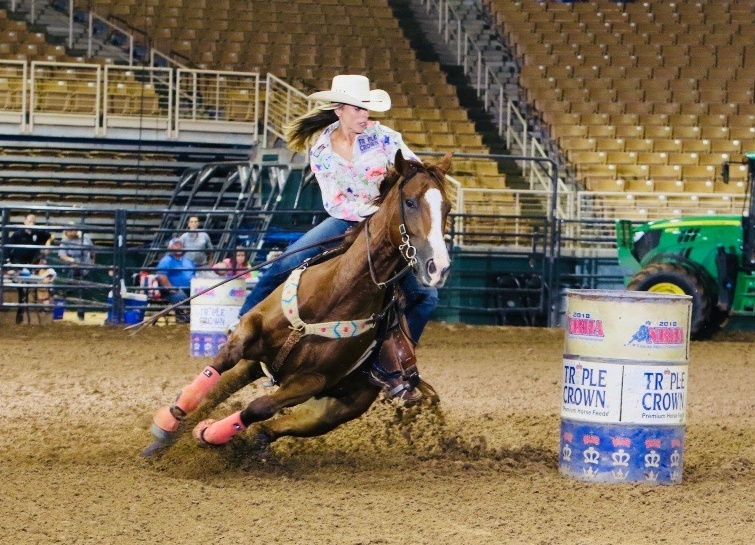
In 2016, Dr. Davis helped Crowther and her 2012 Quarter Horse mare Shes Packin Fame, or “Sissy,” return to the ring after what could have been a detrimental injury. Sissy suffered a rare slab fracture to the central tarsal bone in her left hock while competing in a barrel racing competition. After a diagnosis aided by Palm Beach Equine Clinic’s advanced diagnostic imaging equipment and a surgery performed by Dr. Davis, Shes Packin Fame not only returned to running barrels, but the mare was also back to winning the next year.
When Crowther found a new prospect named Grandiose Guy, or “Mater,” she turned to Dr. Davis to ensure her intended purchase would be a good fit. The Quarter Horse gelding was named the Barrel Futurities of America (BFA) Horse of the Year just after she purchased him, crowning him the top four-year-old in the country.
“When I was thinking about buying him, I called Dr. Davis and sent him videos of the horse working to review,” said Crowther, who started the purchase process late last year and chose to involve Dr. Davis in all aspects of the pre-purchase evaluation. “The horse was in Georgia, so he reviewed them from Palm Beach Equine Clinic in Wellington and gave me the stamp of approval. Once a pre-purchase was performed, I sent all the x-rays to Dr. Davis and he told me to move forward.
“I trust Dr. Davis and the team at Palm Beach Equine Clinic so much!” continued Crowther. “Barrel horses work hard and it’s so important to have a great relationship with the vet who oversees their care and knows them well in order to keep them happy and healthy.”
Regardless of breed or discipline, a pre-purchase exam involves certain steps that allow the potential owner and veterinarian to investigate the horse’s health and condition. The veterinarian gathers and interprets information by physically examining the horse’s body systems and conformation, as well as reviewing the health history. A lameness assessment is completed, including flexion tests, soft tissue structure palpation and movement evaluation. Diagnostic medical imaging tools, such as radiography, ultrasonography, endoscopy, magnetic resonance imaging, nuclear scintigraphy, or computed tomography, may be used to provide a more detailed and comprehensive profile of the horse.
Crowther purchased Mater and started running him at the beginning of last year, bringing him to the largest one-day rodeo, The American, in the Dallas Cowboys stadium in Texas in February. The competition had a $1 million payout and Mater and Crowther placed fifth.

“After so many runs, we brought him home from Texas and got him over to Dr. Davis for any maintenance work that needed to be done to keep him feeling his best,” said Crowther. “I am very picky about where I take my horses; there has to be good ground and I will not run their legs off. In conjunction with that, maintenance work with Dr. Davis is important. He performs flexion tests, utilizes the imaging at Palm Beach Equine Clinic if necessary, and makes recommendations about my horses’ health and overall well-being.”
Dr. Davis sent Mater home from Palm Beach Equine Clinic with a clean bill of health and Crowther gave the gelding a little time off before their next run. After returning to work, Mater headed to the National Barrel Horse Association (NBHA) Florida State Championships in Kissimmee.
Crowther’s diligence and Dr. Davis’ knowledge paid off when Mater won both his runs and clinched the open final at NBHA Florida State Championships. With more than 700 entries, Mater and Crowther topped them all and were crowned overall champions of the event.
“Palm Beach Equine Clinic and Dr. Davis have been a huge part of the success I have had with all of my horses,” said Crowther. “They are always there when I need them, whether I’m headed to the clinic in Wellington or they are coming to me in Fort Meyers. It’s nice to be able to know your vet will be there for you whenever you need them.”
Interns at Palm Beach Equine Clinic are a vital part of keeping the day-to-day operations running smoothly, whether assisting the veterinarians, caring for the horses in the hospital, or attending farm calls. Hailing from Lake Worth, FL, Sidney Chanutin, 26, is a Florida Atlantic University alumni and recent graduate of the University of Florida College of Veterinary Medicine and joined Palm Beach Equine Clinic as an intern this year.
Learn more about Sidney:
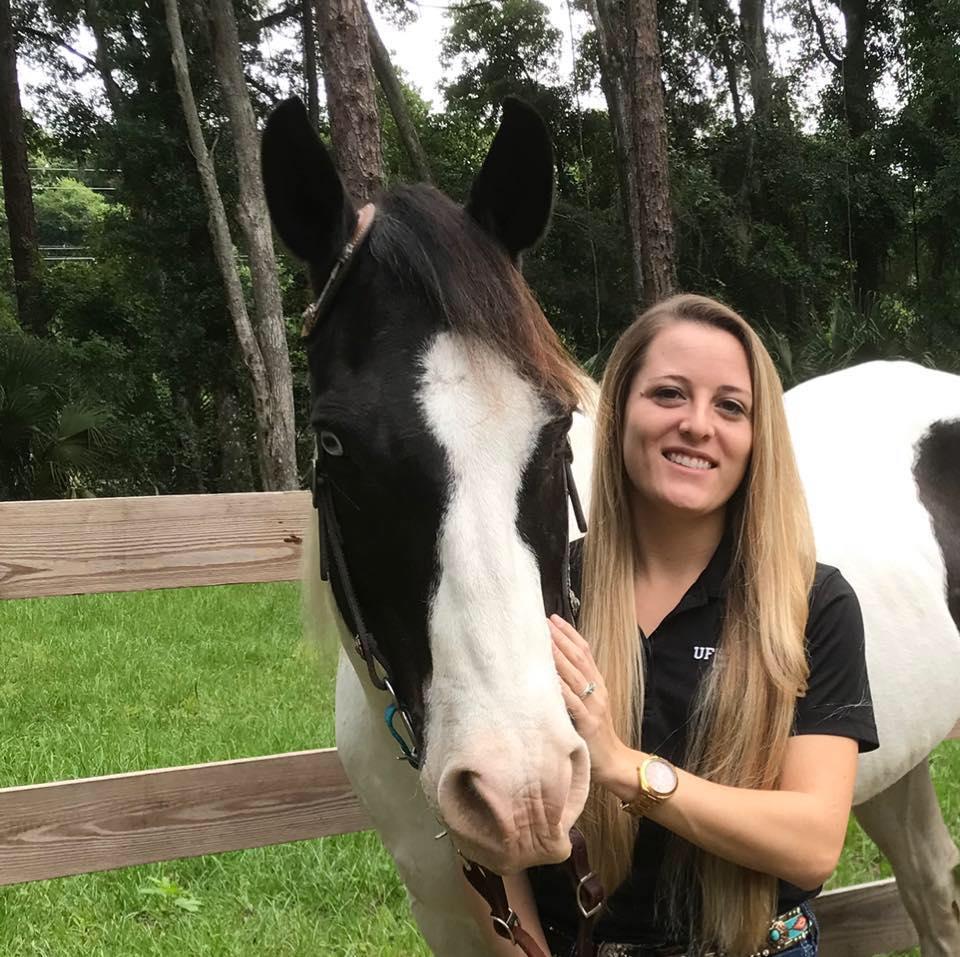
How did you first get involved with horses?
I have always had a passion for horses. I remember as a kid, I was always bugging my parents for riding lessons and to buy my sister and me a pony. I got my first horse when I was eight years old and have been hooked ever since.
What led you to study equine veterinary medicine?
Since before I can remember, my goal has always been to become an equine veterinarian. As a South Florida native, being able to watch the vets at Palm Beach Equine Clinic take such great care of my own horses played a big role in my desire to practice equine veterinary medicine.
Aside from my passion for horses and general happiness when I am around them, I love being able to work outside. The thought of working a nine-to-five job in the same office every day did not suit me. I love being able to travel from farm to farm and see new people every day.
What are your day-to-day responsibilities at Palm Beach Equine Clinic?
As an intern, I am responsible for looking after inpatients, running anesthesia for surgeries, assisting in emergencies, and helping senior doctors with various exams and procedures.
What do you enjoy most about being part of the Palm Beach Equine Clinic team?
The Palm Beach Equine Clinic team is just that, a team. It is amazing to me how all of these people from so many different backgrounds all come together with a common goal—to help horses. That is one of the reasons I chose to do my internship here. Everyone looks out for one another, whether it’s just lending a helping hand or giving advice on a difficult case. I am blessed to have the opportunity to learn from each member of the Palm Beach Equine Clinic staff.
Do you have any stand-out cases that you have really enjoyed working on while at Palm Beach Equine Clinic?
It is hard for me to pick any one case, but I would say that working with the more intensive care patients, such as surgical colics, has been the most rewarding for me. These patients are very sick and require around-the-clock care, so it becomes hard not to become emotionally invested. That being said, having a strong emotional connection to the patients makes the cases where we have good outcomes that much more rewarding. There is no one in the world who gets more excited about bowel movements than a veterinarian who is caring for a patient with colic!
What branch of equine medicine do you enjoy the most?
I am very interested in both sports medicine and rehabilitation as well as ophthalmology.
What can we find you doing when you are not working?
I have two Quarter Horses, “Bolo” and “Ruby,” that I love to take on trail rides. I love spending my time outdoors, so when I’m not riding or taking care of my horses, you can find me fishing with my fiancé.
Thrush, rainrot, and scratches are problems that most equestrians have probably encountered, but in the hot, often humid summer months, these issues can incessantly plague horses and their owners. While different in their presentation, thrush, rainrot, and scratches have a lot in common. For horse owners, there are several problems that arise due to environmental factors or predisposing conditions, but these issues can easily be prevented or treated with proper care and management.
This month, Palm Beach Equine Clinic’s Dr. Bryan Dubynsky shared his expertise on the causes, treatment, and prevention of thrush, rainrot, and scratches.
Thrush
Thrush is an infection within the horse’s hoof most commonly caused by bacteria that invade the deep clefts or grooves (known as sulci) of the frog. Fusobacterium Necrophorum is the common bacterial culprit, which naturally occurs in the environment, especially in wet, muddy, or unsanitary areas. Thrush bacteria thrive where there is a lack of oxygen.
Some horses are predisposed to developing thrush due to conformation, such as a rather high heel or deep sulci, or a narrow or contracted heel. The bacteria will manifest in horse’s feet that are not picked out regularly, or standing in muddy, wet environments, including paddocks or stalls that have not been cleaned properly. Thrush can typically be first identified by the odor. The frog will have a strong, rotten odor and become spongy. Visually, the frog can even exudate (ooze) pus.
The treatment for thrush is fairly simple as it is very sensitive to oxygen. The most important thing is to have your vet or farrier trim or debride the frog to expose affected areas to the air. It is best to keep the hoof clean and dry. Adding a common detergent to the thrush areas, such as Betadine or any commercial product (Thrush Buster, Coppertox, etc.) will help to kill the bacteria. Most importantly, if the horse is not removed from those predisposing environmental factors, treatments can be ineffective.
Maintaining a level of activity for our equine partners will increase blood flow to the feet and promote health in the area. Horses found in dry environments with ample space to move typically do not suffer from thrush. The activity of horses moving keeps the frogs healthier. The more blood flow you have in the foot, the less chance there is for infection to manifest. Thrush does not always cause lameness. In extremely rare cases, thrush can penetrate deeper and cause an infection in deeper tissue or even in the coffin bone. When in doubt, always contact your veterinarian.
Rainrot (Dermotophilus Congolensis)
Rainrot is caused by a naturally occurring bacteria named Dermotophilus, which produces spores. The condition is recognized as scabby, scaly, crusty spots on areas of the horse that have been exposed to rain. It is commonly seen on the neck or across the back (dorsum). Rainrot is not typically apparent on the legs or under the belly. A surplus of rain on the skin washes away the natural protective oils. Once the skin is stripped of the natural protective layer or any sort of trauma to the skin barrier occurs, which can be even as simple as an insect bite, the Dermotophilus spores are able to invade the deeper dermis skin layers. The spores penetrate into the deeper layers of the dermis, and the body reacts by sending white blood cells and proteins to fight the invaders.
This reactive response causes small pustules, scabs, and bumps to form. Similar to thrush, rainrot is an environmental issue. It is most commonly seen in warm areas with high humidity, excess rain, and insects. The most important prevention is to keep horses out of prolonged periods of rain. A horse can be out in the rain for short periods of a day or two, but if it is constantly in hot and rainy conditions with biting insects, more than likely the horse will develop rainrot.
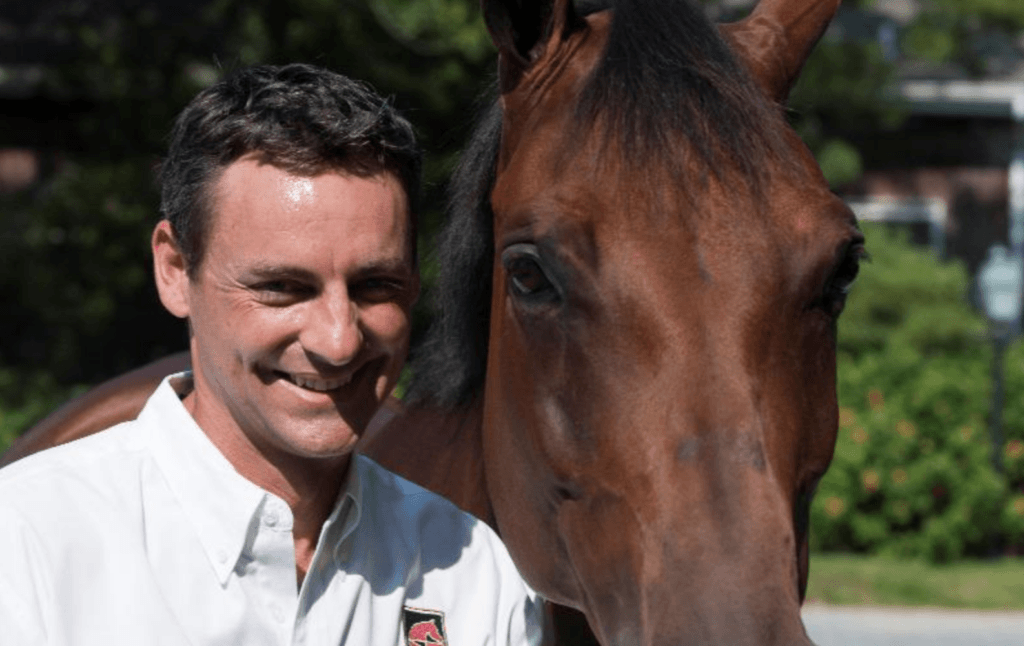
Dr. Dubynsky emphasizes that topical products are not worth anything if the horse is not removed from the environmental factors. Once you remove the environmental factors, a keratolytic agent (something that exfoliates keratin), such as benzoyl peroxide or an antibacterial shampoo, will help the skin heal. He also cautions that if the horse does have scabs, you do not necessarily want to pick the scabs off because then you are leaving open skin without protection for more bacteria to invade. The most important tip to healing is to keep the area dry.
In very rare, severe cases of rainrot, it is best to contact your veterinarian to put the horse on antibiotics. If left untreated, and the horse is not removed from the environmental causative factors, the infestation can lead to Staphylococcal Folliculitis; a type of Staph bacteria that will invade the hair follicles and cause a more serious situation.
Scratches
Scratches is a generic term for many different ailments. The definition of scratches can be a bacterial, fungal, or viral dermatitis or inflammatory condition of the pastern or fetlock. It is defined as a chronic Seborrheic Dermatitis, characterized by hypertrophy and exudation on the palmar plantar surface of the pastern and fetlock.
There are certainly predisposing factors for scratches, including the same environmental factors that cause thrush or rainrot. Predisposing factors for scratches include horses that are bathed often or stand in wet conditions all the time. Horses that have an excess amount of hair on their legs, especially draft horses, may be more prone to developing scratches. This is because the hair traps dirt and moisture on the skin. Scratches can develop in horses that are bathed too often, such as the intensely managed show horse. Frequent bathing of the horse can strip away the natural protective oils and barrier of the dermis. This allows bacteria or fungi to invade. When moisture penetrates the skin, it causes an inflammatory reaction. This presents as heat, redness, pain, and loss of protection to keep bacteria out.
The most effective first step for prevention and treatment should be to eliminate environmental predisposing factors. Removing excess hair during humid months and keeping horses clean and dry to the best of your ability will reduce the probability of developing an infection. Bathing horses once a day with Betadine or antifungal/antibacterial shampoo will help to clear the infection. Be sure to leave the shampoo on for 20 minutes for all of the medicine to penetrate. Rinse thoroughly, and make sure the horse is completely dry. In order to effectively treat the bacteria, horses, especially their legs, should be completely towel- or air-dried before being returned to their stalls or paddocks.
As always, contact your veterinarian immediately if there appears to be a deeper infection present, or if you would like more detailed information on how to treat and prevent these bacterial infections. To contact your Palm Beach Equine Clinic veterinarian, call 561-793-1599 or visit www.equineclinic.com.
When dressage rider Meagan Davis and owner Scott Durkin think about the goals they have for their dressage horse Royale, they have tunnel vision for the grand prix ring. Royale, a 16-year-old Oldenburg gelding (Routinier x Ironman) was well on his way to accomplishing that goal during the 2019 season when something strange started happening.
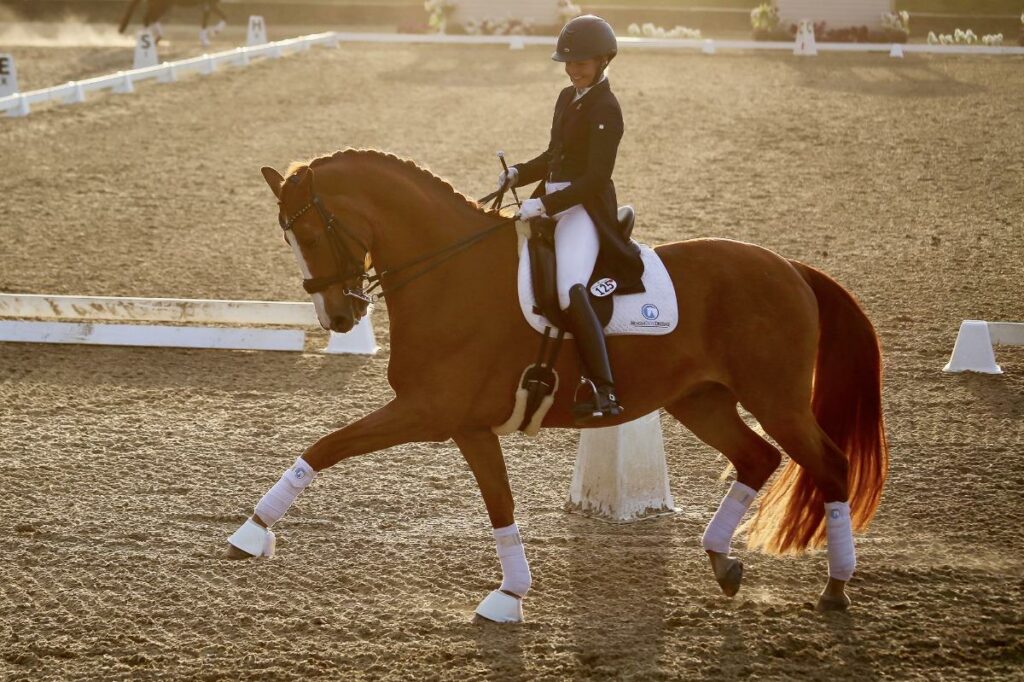
Photo courtesy of Meagan Davis
After arriving at their winter home in Loxahatchee, FL, from a northern base in Stone Ridge, NY, Davis kicked off Royale’s winter competition schedule with a show in January. The horse was coming off a very successful fall season that included CDI Intermediaire I and CDI Prix St. Georges victories at the New England Dressage Fall Festival and Dressage at Devon.
“Our first show was unusually chilly and I noticed that Royale was breathing a little hard and didn’t sweat very much,” recalled Davis. “I didn’t think that much of it because of the weather, but when we returned home and it warmed up, he wasn’t sweating at all.
“He could not catch his breath after being perfectly fit a month before,” continued Davis. “I rely on Palm Beach Equine Clinic for the care of all the horses in my barn and I immediately turned to Dr. Robert Brusie.”
Dr. Brusie is a Board-Certified Surgeon at Palm Beach Equine Clinic and was diligent about ruling out any physical causes of Royale’s obvious discomfort and decline in performance. After flexion tests, checking for musculoskeletal problems, and assessing soreness or wear and tear, Dr. Brusie turned to Palm Beach Equine Clinic’s Internal Medicine Specialist Dr. Peter Heidmann.
“Dr. Brusie was watching me work him one day, noticed the decline in muscle, the lack of sweating, and labored breathing, and recommended we take a deeper look with a specialist,” said Davis. “That is why I trust Palm Beach Equine Clinic with the care of my horses. They have so many tricks up their sleeves, and their clients are fortunate that the veterinarians collaborate so well together in order to do what’s best for the horse.”
Dr. Heidmann’s first step was to asses any neurological causes by testing for equine protozoal myeloencephalitis (EPM) and Lyme disease. Both were negative. He then moved on to a nutrient analysis.
“When you see weakness and poor muscle mass in a horse, two of the things you test for right away are vitamin E and selenium deficiencies,” said Dr. Heidmann. “Both are common causes of decreased performance due to low concentrations in local soil or the soil where a horse’s hay derives from.”
No deficiencies were found in Royale, which prompted Dr. Heidmann to move on to muscle testing. He drew blood from Royale, put him in work, and then drew blood again four to six hours later. When comparing enzymes in the blood from before and after work, Dr. Heidmann looked for any large increase, which would indicate the problem was in the muscles themselves. Royale’s tests, once again, came back normal.
At this point, Dr. Heidmann returned to the case history and started following the shortness of breath symptom, noting, “Breathing abnormalities in horses are difficult to diagnose by simply listening because their chest wall is so thick. What I wanted to asses was prolonged recovery. This is done by placing a bag over a horse’s nose to get them to breathe deeply. Once the bag is removed, breathing should regulate within two to three breaths. Royale needed four to five breaths.”
Once Dr. Heidmann identified a possible cause, he performed abronchoalveolar lavage (BAL), which is essentially a lung sample used to identify abnormal cells. He inserted a small-diameter tube through the trachea, flushed saline into the lung, and then suctioned it back out.
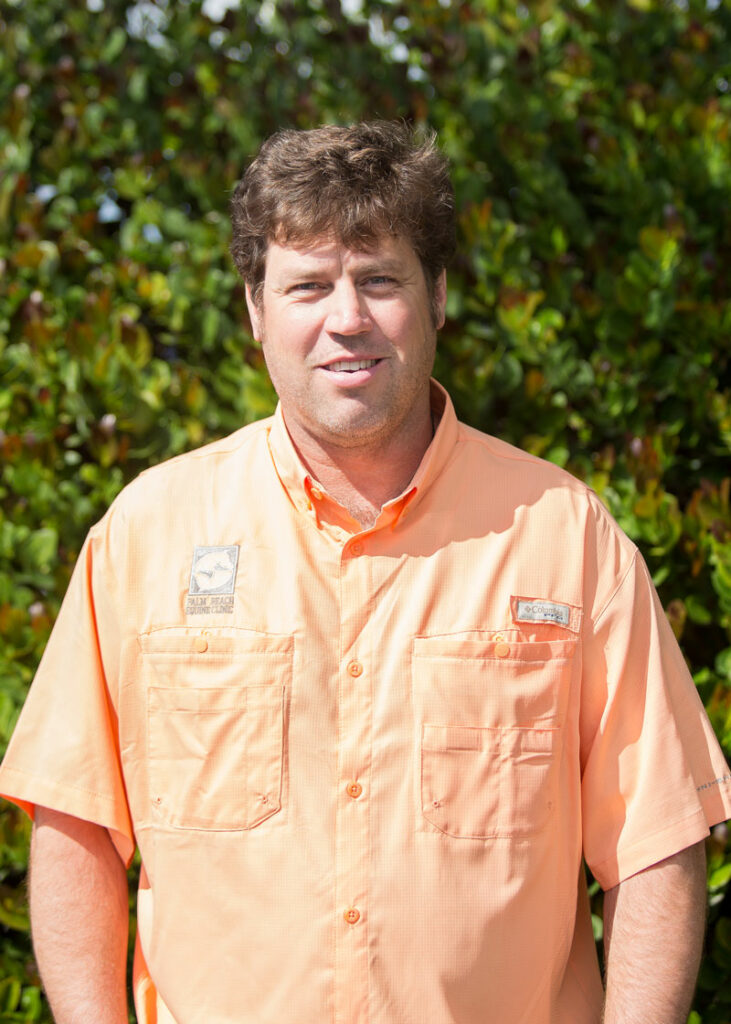
“Sure enough, when I examined the sample, there was mucus and abnormal cells,” said Dr. Heidmann. “Despite his bloodwork being normal and no obvious infections, Royale was battling equine asthma or ‘heaves.’”
The treatment for asthma in horses is very similar to what’s done for humans and includes an anti-inflammatory bronchodilator drug and inhaled steroids.
“While his breathing issues were significant enough to affect performance, Royale’s treatments were relatively mild with immediate and substantial improvement,” said Dr. Heidmann. “I used nebulized herbal remedies, steam, and Ventipulmin, which is an oral syrup.
“I’m a less-is-more person and veterinarian,” he continued. “I try to have the best outcome with the least amount of medications. Additionally, we created some routines that would minimize environmental dust and allergens, such as using a hay net, wetting down hay and bedding, or using chopped newspaper as bedding.”
Royale stayed on the prescribed medication through his trip home to New York and came off them at the end of May. Today, he is back in work and has regained the fitness and muscle he had during the fall. According to Davis, their goal is to step into the grand prix ranks during the upcoming season.
“My favorite cases are the sickest of the sick and the most elusive needle in a haystack,” concluded Dr. Heidmann. “Royale’s case definitely fell into the latter. It was really challenging, but rewarding because the outcome was a horse that is dramatically different than he was four months ago. But the most important part of this case for me was working together with Dr. Brusie. I would have not been successful in helping this horse if he hadn’t done all the work prior to coming to me. That kind of collaboration is what contributes to our success and sets Palm Beach Equine Clinic apart!”